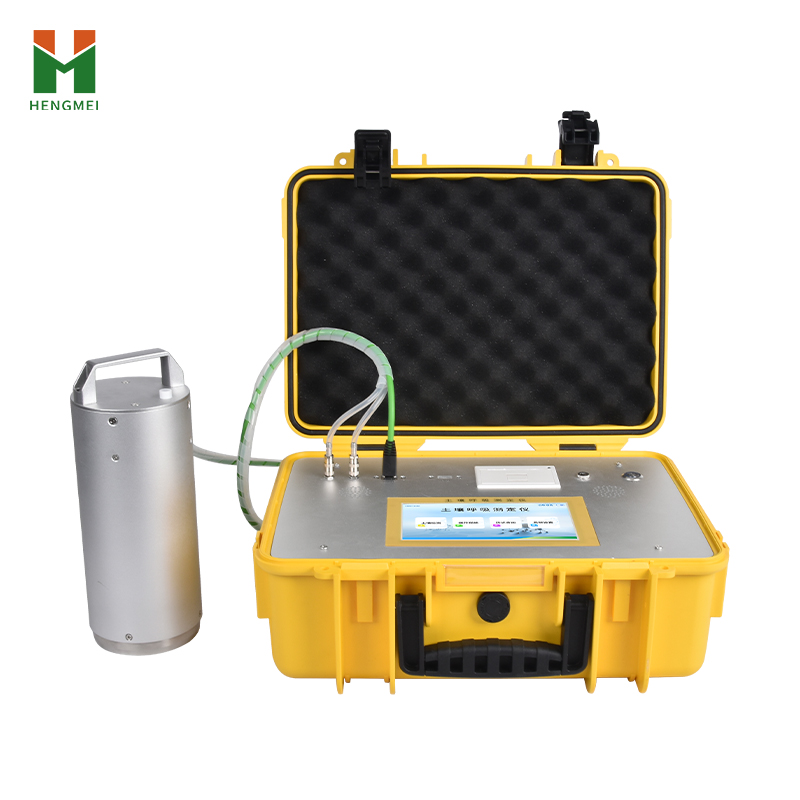Soil, as a vital component of the Earth's ecosystem, plays a crucial role in global climate change and sustainable agricultural development. Soil respiration, a core process in the carbon cycle of soil ecosystems, serves as a key indicator of soil vitality. The advent of soil respiration measuring instruments has provided powerful technical support for accurately capturing soil respiration processes and analyzing soil ecological functions.

Importance of Soil Respiration: Why Accurate Measurement Matters
Soil respiration refers to the process by which microorganisms, plant roots, and other biological activities in the soil release gases such as carbon dioxide (CO₂) into the atmosphere through metabolic processes. It is the primary pathway for terrestrial ecosystems to release carbon into the atmosphere, with annual carbon emissions far exceeding those from fossil fuel combustion. Its significance is reflected in the following aspects:
In climate change research, soil respiration is a critical component of the carbon cycle. Accurately understanding the intensity and patterns of soil respiration helps assess the role of soil as a carbon source or sink, providing essential data for predicting climate change trends. For example, enhanced soil respiration releases more carbon into the atmosphere, potentially exacerbating the greenhouse effect, while improved soil carbon sequestration capacity can help mitigate climate change.
In agriculture, soil respiration intensity is closely related to soil fertility and microbial activity. Fertile soil with active microorganisms exhibits moderate soil respiration intensity, providing ample nutrients for crop growth. Abnormal soil respiration may indicate soil degradation or declining fertility, and timely monitoring can guide the optimization of farmland management practices.
Furthermore, in ecological restoration and land-use change studies, changes in soil respiration serve as important indicators for assessing ecosystem recovery and the rationality of land use. Thus, accurate measurement of soil respiration is indispensable for research and practices across multiple fields.
Working Principle of Soil Respiration Measuring Instruments: Precision Mechanisms for Capturing Gas Changes
The core function of soil respiration measuring instruments is to monitor changes in gas components and related environmental parameters during soil respiration in real time. Their working principle is based on gas exchange and detection technologies.
The instrument forms a relatively sealed space with the soil surface using a respiration chamber. When soil respiration occurs, gases such as CO₂, N₂O, and CH₄ are released into the chamber, while changes in H₂O content, temperature, and atmospheric pressure within the chamber are also detected. Soil respiration measuring instruments are equipped with high-precision gas and environmental sensors to rapidly and accurately capture these changes.
For gas component detection, infrared spectroscopy or gas chromatography principles are typically employed. For example, in CO₂ detection, infrared light of specific wavelengths passes through the gas in the respiration chamber and is absorbed by CO₂ molecules. The absorption intensity is proportional to the CO₂ concentration, and the instrument calculates the CO₂ concentration by measuring the degree of infrared attenuation. Similarly, specific detection methods are used for gases like N₂O and CH₄.
Simultaneously, monitoring temperature and atmospheric pressure provides critical data for correcting gas concentrations, as gas volume and concentration are influenced by temperature and pressure. By collecting these parameters in real time and combining them with gas concentration data, soil respiration measuring instruments can accurately calculate soil respiration rates and gas emissions.
Technical Advantages of Soil Respiration Measuring Instruments: Precision, Efficiency, and Versatility
Soil respiration measuring instruments demonstrate numerous advantages in soil respiration monitoring due to their advanced technical design:
First is the capability for multi-parameter synchronous monitoring. The instrument can simultaneously display real-time changes in CO₂, H₂O, N₂O, CH₄, temperature, and atmospheric pressure within the respiration chamber, eliminating the need for multiple instruments and significantly improving monitoring efficiency. This ensures data synchronization and consistency, providing a comprehensive data foundation for analyzing soil respiration processes.
Second is high precision and sensitivity. Advanced sensor technologies and data processing algorithms enable the instrument to achieve high detection accuracy for gas concentrations, capturing minute changes and accurately reflecting subtle dynamics of soil respiration. This is crucial for studying diurnal and seasonal variations in soil respiration.
Third is portability and field monitoring capability. Many soil respiration measuring instruments are compact and lightweight, making them easy to carry for field measurements. Without the need to transport soil samples back to the laboratory, errors during sample handling and transportation are minimized, ensuring the authenticity and representativeness of monitoring data.
Additionally, user-friendly operation and high automation are significant advantages. The instruments typically feature intuitive interfaces and data recording systems, allowing users to easily set monitoring parameters and initiate the process. The instrument automatically completes data collection, storage, and preliminary analysis, reducing human error and improving工作效率.
Application Fields of Soil Respiration Measuring Instruments: Broad Coverage Across Multiple Disciplines
Soil respiration measuring instruments are widely used across various disciplines and research directions:
In agricultural ecological research, monitoring soil respiration changes under different farming practices and fertilization measures helps assess the impact of agricultural management on soil carbon cycles and fertility, providing a basis for developing sustainable agricultural strategies.
Carbon source and sink research relies on accurate data provided by soil respiration measuring instruments. By measuring soil respiration rates in different ecosystems (e.g., forests, grasslands, wetlands) and combining them with other carbon cycle studies, the role of various ecosystems as carbon sources or sinks can be clarified, offering scientific support for national carbon emission reduction goals.
In global climate change research, soil respiration measuring instruments are used to study the impact of climate change (e.g., rising temperatures, precipitation changes) on soil respiration and the mechanisms by which soil respiration feedback influences climate change, contributing to the refinement of global climate models.
Land-use changes significantly affect soil respiration, such as deforestation for farmland or urbanization. Monitoring soil respiration dynamics during these changes with soil respiration measuring instruments helps assess the environmental impact of land-use changes.
Furthermore, in ecological restoration, monitoring the recovery of soil respiration during restoration processes can evaluate the effectiveness of restoration measures. Soil respiration measuring instruments also play important roles in assessing soil microbial activity, plant ecological research, insect and root respiration studies, and fruit storage.
Solutions: Monitoring Strategies for Different Scenarios
Soil respiration measuring instruments offer customized solutions for various research and application scenarios:
For long-term fixed-point monitoring, soil respiration measuring instruments can be integrated with automatic weather stations to build long-term monitoring networks. The instruments can automatically collect soil respiration and environmental parameter data at regular intervals and transmit the data to management platforms via wireless technology, enabling remote monitoring and analysis of long-term soil respiration dynamics.
For portable field monitoring, suitable respiration chambers (e.g., static or dynamic chambers) are selected based on soil type and vegetation cover. Operators carry lightweight soil respiration measuring instruments for rapid deployment in the field, obtaining real-time soil respiration data to meet the needs of field surveys and short-term experiments.
For laboratory simulation experiments, collected soil samples are placed in controlled-environment incubation devices. Soil respiration measuring instruments monitor soil respiration changes under different conditions (e.g., temperature, humidity, gas concentrations), enabling in-depth study of the regulatory mechanisms of soil respiration.
Soil respiration measuring instruments, as key tools for analyzing soil life activities, play an irreplaceable role in soil respiration monitoring. They accurately and efficiently capture gas changes and environmental parameters during soil respiration, providing strong technical support for research and practices across multiple fields.
From agricultural ecological research to global climate change studies, from carbon source and sink assessments to ecological restoration monitoring, the application scope of soil respiration measuring instruments continues to expand, addressing industry pain points and contributing to the development of related disciplines. With ongoing technological advancements, soil respiration measuring instruments will become more intelligent and precise, offering even greater support for understanding soil ecosystems and addressing global environmental challenges.
Article address:https://www.soiltesting.cn/news3/117.html






